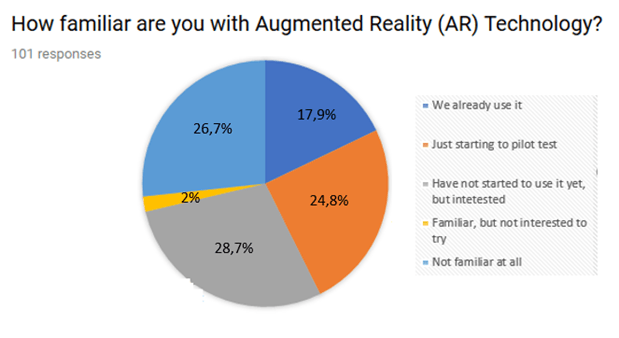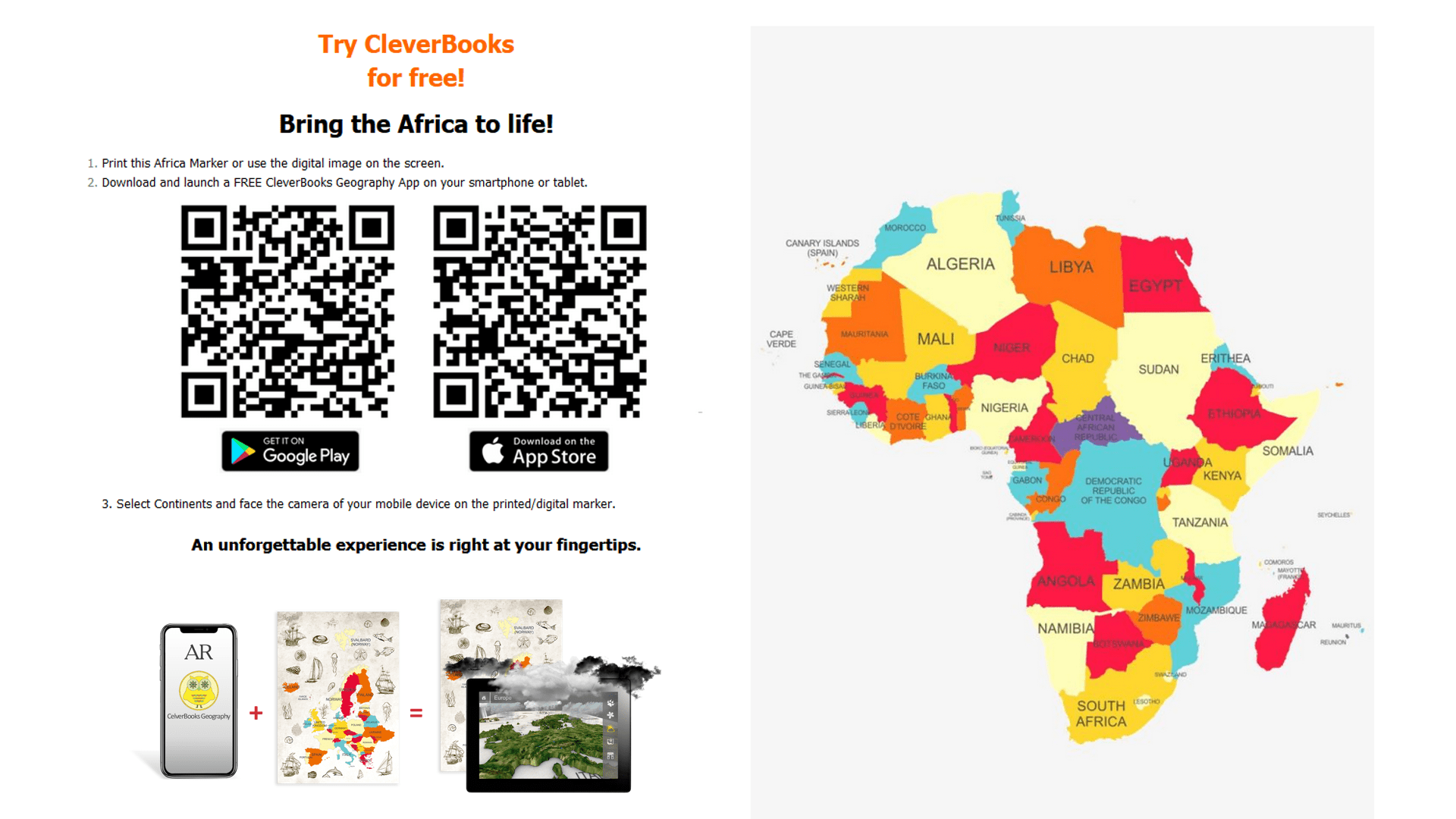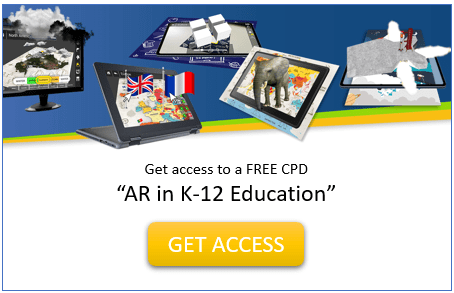Reading time: 15 minutes
Technology will never replace great teachers, but technology in the hands of great teachers is transformational.”
George Couros, educator and author of The Innovator’s Mindset

Intro
In 2017 CleverBooks team has conducted a research project “Technology in a Classroom – Augmented Reality is the Future of Education” to grasp an overview of the integration of immersive EdTech in the K-12 education sector. A more recent study followed in 2019-2020 as part of the DBA research project by Dr. Inna Armstrong, Co-Founder of CleverBooks focused on the topic of immersive EdTech integration in the education sector.
Survey
This article presents data collected from a computer-based survey that includes the response from 101 educators (Pic. 1) all around the world and focus group interviews with educators during the doctorate study.

Pic. 1. Geographical location of survey participants.
In more detail, the topic of EdTech adaptation in the K-12 educational sector is introduced in the “Digital Transformation in K-12. Practical Playbook“ e-book published by CleverBooks in August 2020. It provides practical advice to educators on how to start, maintains, and be on top of digital transformation in their school.
Additional
HolonIQ (the education intelligence provider) published a report pointing out that less than 3% of total global education expenditure is currently digital. It, therefore, opens tremendous opportunities for growth potential and market transformation in the upcoming decade. The Global EdTech market is projected to reach $342B by 2025.
However, bringing education to the technological era and maintaining curriculum, is still a challenge for schools worldwide. Improving the quality of education requires an innovative mindset and adaptation of educational technology at the K-12 schools addressing the needs of a 21st-century society where the technologies are used strategically to benefit students’ learning. EdTech serves as an excellent means to deliver multimedia and interactive course content to today’s generation of digitally connected students anytime, anywhere, and across devices.
Part 1
The research data covers participants from public and private educational institutions at the K-12 stage (Pic. 2) to provide an overview of the state of integration of educational technology within different school types. Pic. 3 presents the survey participant’s age and gender summary. The two most dominant age groups of the respondents are between 36-45 years old (36,6%) and between 46-55 years old (32,7%).

Pic. 2. Education institution operation sector.

Pic. 3. Participant’s age and gender summary.
Part 2
The diversity of job titles with the level of seniority of the survey participants are represented in Pic. 4. The majority of research participants hold a principal or assistant principal position (28%), technology coordinators and innovation directors/coordinators represent 25% of participants, 19% of respondents – lead teachers, and the rest of the sample represent other job titles within the educational institution.

Pic. 4. Participant’s job title summary.
Part 3
The series of questions below provide a general overview of participants’ opinions toward the current state of EdTech adaptation at the K-12 schools and its potential to drive change in the education system.

Pic. 5. Importance of integration of technology in Education.
Many schools worldwide are now struggling to maintain relevance in their classes due to rapid changes in the job market. In the digital world, educators are under tremendous pressure of equipping students with skills necessary for the unknown future workforce.
Part 4
According to the research, over 90% of participants have a positive attitude towards implementing and using the technology in the classroom (Pic. 5). This suggests that schools are on the road to digital transformation in education where EdTech in the classroom is an essential part that shapes the 21st-century classroom learning environment.
Some individual thoughts and opinions of global educators on the topic of emerging technologies in education can be found in the podcast series: Talks on Emerging Technologies in Education and a free e-book “EdTech at School” co-authored by global educators to discover new ways of teaching and learning with EdTech!

Pic. 6. Current ICT infrastructure.
Part 5
Despite the importance of technology integration in the educational process, schools have a challenge having a sufficient ICT infrastructure to enable the adaptation of new technologies and e-learning material. Pic.6 presents the level of maturity of current ICT infrastructure in schools of participants: over 69% of respondents identify it as ideal or very good to support students learning demands.
It shows that those schools are well settled on the journey of monetarization of their educational system and promote the integration of immersive EdTech. However, over 27% of participants pointed out that their ICT environment just works or not sufficient enough to implement positive and disruptive change. Furthermore, 3% point out the outdated ICT infrastructure or lack of staff in place to make effective use of it.

Pic. 7. Teaching Staff’ technological proficiency.
One of the most common concerns that teachers have is a fear that technology will eliminate their jobs, but the reality of today’s world shows the opposite! The teacher’s role now is to facilitate the use of technology in the classroom making sure students learn to use the technology strategically.
Part 6
Pic. 7 shows the research results on the level of technical proficiency of the staff members of participants’ schools rating them on the scale from 1 (beginner) to 5 (excellent). In varying degrees, the staff members of different K-12 educational institutions have different technological proficiency abilities.
- Only 4% of respondents stated that their staff members have excellent skills and knowledge to use technology in the classroom effectively.
- Over 89% of the participants have indicated that their staff demonstrates good and above good technology proficiency, thus, comfortable in using the EdTech in the classroom.
- Furthermore, 5,9% of participants indicated that their staff members have challenges in adopting and using technology as part of the teaching, thus, require technology training to help them effectively use technology resources in their classrooms.
Part 7
One of the free digital courses “Technology for Your Classroom” is available for educators to view on the teachable. It gives an introduction to technology that is available out there with a list of suggested free resources and additional information for professional development.

Pic. 8. Hardware device preference.
AR Adaptation
The effective adaptation of immersive EdTech requires sufficient hardware for teachers to onboard and use e-learning material with students. Pic 8 shows a variety of the hardware used by schools of survey participants to align technology provision with digital curricula. The extensive use of laptops and PC suggest that schools are limited to the available digital content. Some schools additionally complement their ICT infrastructure with iOS or Android-based mobile devices allowing them to explore a wider range of digital content.
2017

2020

Pic. 9. Comparison from research in 2017 and 2020. EdTech planned to be integrated.
In the 2017 research, we presented a list of EdTech that schools had on their wish list for the upcoming years. The 2020 study figures show which innovative EdTech participants planning to integrate in the nearby future. It demonstrates the EdTech that would be of higher demand for integration into the teaching and learning process over the coming years. Looking at the comparison graphs it is clear that Augmented and Virtual reality (AR/VR) technologies still remain a major interest for educators.
TedEd
Dr. Darya Yegorina, CEO of CleverBooks in her TEDx Talk “Augmenting Education” in 2019 pointed out that: “Augmented Reality is a visual technology that helps students See, Hear, and Touch the Knowledge setting them on a path to success in the digital future workforce”. A wide range of teaching methods and best pedagogical practices using AR resources in the classroom were presented by 40+ global educators at the AR for K-12 Education Summit 2019 showing the potential of this immersive EdTech for schools. Furthermore, the “Augmented Reality at School. Practical Guide for Educators” e-book, co-authored by global educators, teachers how to apply AR for K-12.

Pic. 10. Educators level of familiarity with AR Technology.
In 2016 Goldman Sachs projected for the Augmented reality in the Education industry to reach a $700 million market by 2025. More recent research published on Markets and Markets suggests that the global augmented, and virtual reality (AR/VR) in education market size is projected to grow to EUR 17.3 billion by 2023.
The research results show that over 42% of participants already use or just started piloting AR in their classroom, moreover, further 28,7% have not yet adopted the technology, but interested to use it in the upcoming future. This points out the increasing interest in what this technology can offer to both teachers and students.
Summary
The respondents were asked to also outline their main focus on bringing Augmented Reality (AR) technology to the educational process. According to the responses received, it is possible to state that the majority of research participants believe that augmented learning:
- a) can help students with the visual perception of material bringing subjects to life, ability to present material in 3D making the abstract real and do experiments that otherwise would not be possible in reals life,
- b) sustain student’s motivation to learn and increased students’ participation in the class lessons thought an interactive and engaging learning environment, and
- c) enhance students’ understanding of subjects and their academic performance by developing the necessary skills required from the 21st-century workforce.
Therefore, research participants see AR as a great supplementary technology to the existing school curriculum that allows a student to be an active participant in their learning process and can balance students’ diverse learning needs.
Your next spet
The great examples of AR educational resources are:
- a range of CleverBooks physical products that work a mobile application,
- Augmented Classroom– a digital platform where students can explore, create, and collaborate in Augmented Reality through a multi-player interactive environment in real-time.

To conclude the research, it is important to stress that the lockdown in 2020 due to covid-19 has speeded up the technology adaptation in K-12 regardless of how ready schools were. Today, it is more than even important for educators to have a strategic plan in place for EdTech integration to facilitate the needs of digital-natives and overcome the challenges of modern society. Strategic planning for digital transformation is the key to a new normal. Furthermore, Augmented Reality technology still remains a leader with arising potential for adaptation in the education sector in the upcoming years.

